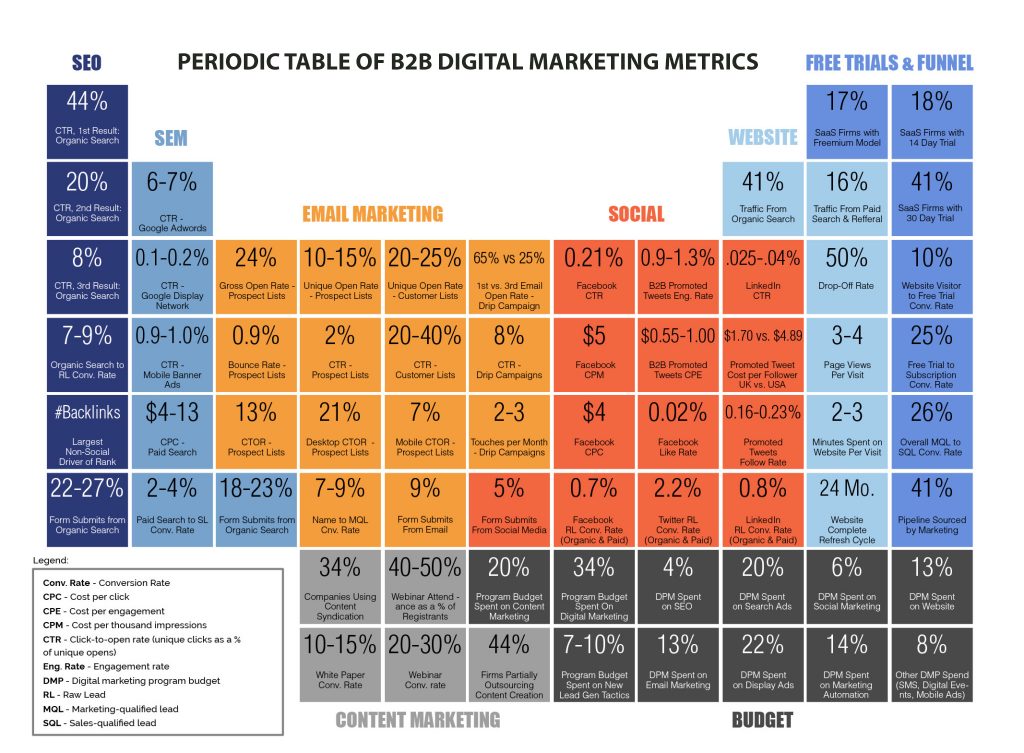
Digital Media is moving fast. From AI recommendations in Facebook, to predictive performance models and intensive big data and sales analysis, there’s a renaissance happening in the world of media that is changing how we do everything. President & Chief Strategy Officer Jeff Roach identifies six ways how we measure marketing impact as a result.
Over the last three years, “performance marketing” has become a buzzword as marketers budgets shift to digital media and the platforms like Facebook and Google are providing a new level of consumer targeting and direct messaging that is transforming how we build brands. With this shift has come a new set of best practices in measuring marketing performance that has directly impacted how we look at brand performance. In some ways, the same principles that have guided brand management still apply and have simply been adapted to modern technology. But we also have entirely new ways of measuring performance as a result of the digital world order. That said, it’s surprising how many brands still focus on the metrics of past decades like impressions, click-through-rates (CTRs), and cost-per-click (CPC) when they do little to connect with true return of brand performance. It’s a complex set of metrics and navigating to find the measurement that matters is not always an easy task.

Here’s six ways that digital media has changed how we measure marketing impact:
1. Video Completes
So we’ve all learned something as marketers and agencies over the last couple years in digital media. NO ONE finishes watching promoted videos online. With 70-80% completion rates viewed as successful, this metric has become a defining measurement for understanding the effectiveness of your creative’s ability to connect with an audience and keep them engaged with your message. Most creative still does all of the branding and CTA in an end card format, essentially putting the hard-working part of the commercial where no one will see it. Evaluating completion rates can provide immediate creative testing results, and give the media and creative team a sense as to how well a brand story or communication goal is landing with consumers and indicate creative and even brand health. 10 years ago, we planned creative expecting that almost every spot or video would be viewed to the end due to the media platforms and history of the :30s spot. Today, creative teams need to think very differently about how they deliver a message in both short and long-form content, and even re-think the traditional narrative architecture of beginning, middle, and end. Thinking differently about the order we deliver a story and a brand message, and watching this metric closing as both a creative and brand health metric, is a key new measurement tool specific to the age of digital media.
2. Time Spent
Although this has become a key metric across a number of platforms, it was Snapchat who showed us that time spent on brand creative could be of such short time frames, measured in a few seconds, that it’s somewhat amazing that brands pay to advertise on the platform. But creative formats and thinking differently about content and messaging has shown that innovation in short-form content when done well can make an impact. If you’re a DTC brand, selling direct-to-consumer on Instagram for instance where a short video swipes up directly into an e-commerce product page, Time Spent can become a key indicator for understanding how well your product message is connecting with the audience and how well your embedded e-commerce store is moving consumers down the funnel and generating interest and purchase consideration in the brand. Although Time Spent has been a metric employed in websites for many years, digital consumer experiences are getting shorter and shorter, and keeping people into your brand is increasingly becoming more difficult and more costly for marketers. Use this as a tool to measure effectiveness of creative in certain channels and to understand your ability to drive people down the funnel. For Boost Mobile, SCS created an HTML5 game called Galactic Thunder Pony that after a swipe-up ad, kept users not for seconds inside Snap like the average brand impression, but reached average engagement times of over 10 mins on the platform, showing us that we could use short-form media to create deeper and more lasting brand connections.
3. Engagement
Engagement is more than just a double tap on an Instagram post or a comment on Facebook, it is a direct connection with a consumer that is telling you exactly what they think about your content. Engagement is typically measured as a collection of reactions to social media posts, both organic and paid. Comments, Likes, Views, and Shares can all make up the Engagement metric, making it at times a bit elusive as far as understanding what a good benchmark for Engagement should be. This type of metric is imperative for measuring brand health and relationships with your current and potential customer. By monitoring the types of engagements received, brands can gauge how the audience is choosing to participate with the brand. Testing variable creative and copy and watching shifts from Likes to Shares shows an increased level of intent or interest, whereas a shift to comments can provide deep learnings into consumer perspective. Additionally, by adding sentiment measurement to determine whether the engagement is positive or negative is a massively telling metric that gives a brand clear directionality from the people that matter to them. I find Engagement one of the more interesting digital media metrics, as high engagement with content or paid social advertising indicates that the creative is connecting on an emotional level or is proving an ability to drive conversation and interest
4. Purchase Consideration
Direct sales are a fantastic metric for results on social, but for any non-DTC brand, this is an unlikely connection that can be made across digital channels. For example, Borla exhaust sells through distribution channels and retailers but social is still delivery strongly for a key metric in purchase consideration through a multi-metric measurement process that looks at clicks on the “Find a Dealer” button. A Purchase Consideration metric is not necessarily a global best practice leveraged by all performance marketers, but Purchase Consideration is a long-standing marketing metric that used to be uncovered via consumer studies designed to understand what prompted a purchase a retail. A number of different actions can ladder up to a Purchase Consideration metric. For our work for BlackBerry, SCS measured landing page visits, clicks to a product page (a mid-funnel indicator of Purchase Consideration) and then clicks on a Where to Buy button to find a retailer (a lower-funnel indicator of Purchase Consideration). We then tracked retail sales and compared our Purchase Consideration metrics with the timing of actual sales based on the region for that media and retailer. Purchase Consideration can include a number of different actions that the consumer takes and we recommend tracking various positive indicators through digital platforms that show the client is thinking about purchase.
5. ROAS
Although a long-standing marketing metric, Return On Ad Spend has become the holy grail of measurement due to the rise of e-commerce and DTC brands selling direct-to-consumer through digital media. Because we can now serve an ad and track it the entire way through the purchase funnel through to sale online, we can determine a Return On Ad Spend immediately and track that $1 spent in converting into $3 sale. Although a 1:3 benchmark is often discussed as the minimum ROAS any brand would like to see, learning your ROAS for our brand or set of products and understanding how to optimize ROAS is potentially one of the most important marketing performance indicators for nay direct-to-consumer e-commerce brand. More challenging, is how to determine ROAS for a brand sold at a third-party retailer where the marketer doesn’t have a direct line between digital media and final sale. Here, like in the BlackBerry example in Purchase Consideration, a number of different metrics and analysis can be executed to determine a Return On Ad Spend. With digital media and performance marketing, this isn’t that hard to do, especially when tracking through to e-commerce DTC sale. But in integrated media plans, especially where above-the-line media like broadcast TV is a part of the plan, understanding Attribution and the impact of ROAS on a channel-by-channel level becomes far harder to understand. More on Attribution in a future post.
6. Sentiment
In the past, to understand Brand Health, marketers would have to employ lengthy and costly quantitative studies to measure how their brand was performing on a series of scales with consumers. Is the brand liked, and how much compared to competitors? What attributes of the brand are moving that needle? How small or large is the brand conversation—are people talking about the brand more or less than the competitors? Social Media has completely democratized this measurement and social media tools now can report on Sentiment in near real-time, showing how many conversations are happening about the brand in comparison with competitors, and how positive or negative or neutral those conversations are, creating a Sentiment score for every brand in the category. This is a powerful metric that allows a brand to track their top-line brand health month-to-month. Smart agencies and marketers should be using Sentiment and measuring monthly with a drive to increase the total positive sentiment of the brand, as well as grow the total number of conversations. Although this isn’t necessarily a typical paid media or performance measurement metric, when looked at against digital media spends, particularly in paid social advertising, it can become a powerful indicator of impact. Sentiment, when combined with Net Promoter Score (another, now much faster and cheaper way to measure brand health), gives brands a sense of health and positive momentum in a way that a $50K-$100K quant study would have been necessary in the past.
Get beyond measurement of impressions, CTRs, and CPC, and start to focus on the digital metrics that matter and provide a true measure of brand success. By developing creative and media strategies that think about things like Video Completes, Time Spent, and Engagement, you’ll create more effective work that’s designed for the modern media landscape.

